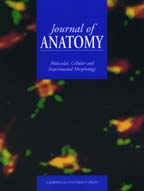Article contents
Growth factor action in neural crest cell diversification
Published online by Cambridge University Press: 01 November 1997
Abstract
At the onset of their migration into the embryo, many neural crest cells are pluripotent in the sense that they have the capacity to generate progeny that consist of more than one cell type. More recently, we have found that there are pluripotent neural crest cell-derived cells even at sites of terminal differentiation. These findings support the notion that cues originating from the microenvironment, at least in part, direct neural crest cell type specification. Based on the rationale that growth factors that are known to support survival of neural crest cell derivatives may have additional functions in progenitor cell development, we have examined the action of pertinent growth factors. Trophic, mitogenic, antiproliferative and differentiation promoting activities were found. Stem cell factor (SCF) is trophic for pluripotent neural crest cells. Contrary to expectation, SCF plus a neurotrophin, rather than SCF alone, is trophic for committed melanogenic cells. Basic fibroblast growth factor (bFGF) is mitogenic both for pluripotent cells and committed melanogenic cells. However, the cells become dependent on another factor for survival. Whereas any neurotrophin tested can rescue bFGF-activated pluripotent neural crest cells, the factor that rescues melanogenic cells remains to be determined. Transforming growth factor β1 (TGF-β1) is a powerful antimitotic signal for all neural crest cells that overrides the bFGF/neurotrophin proliferative signal. Furthermore, SCF promotes differentiation of neural crest cells into cells of the sensory neuron lineage. Neurotrophin-3 (NT-3) specifically promotes high affinity uptake of norepinephrine by neural crest cells and is thus thought to play a critical role in the differentiation of sympathetic neuroblasts. In summary, our data indicate that neurotrophins and other pertinent growth factors affect survival, proliferation and differentiation of neural crest cells at multiple levels and in different lineages. Moreover, our findings emphasise the importance of the concerted action of combinations of growth factors, rather than of individual factors.
Keywords
- Type
- Review
- Information
- Copyright
- © Anatomical Society of Great Britain and Ireland 1997
- 32
- Cited by




